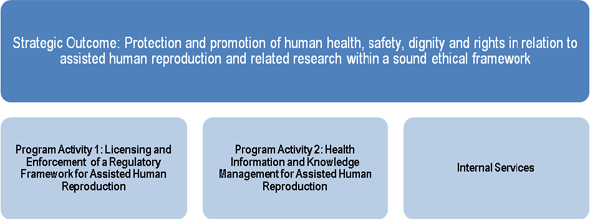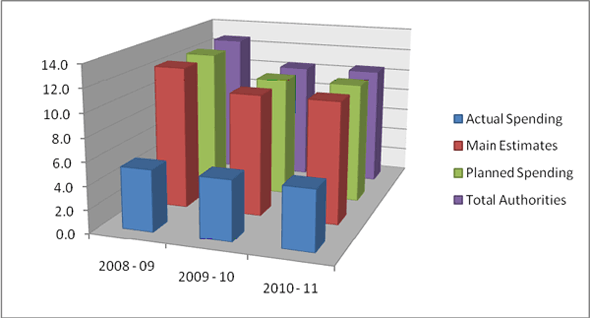Common menu bar links
Breadcrumb Trail
ARCHIVED - Assisted Human Reproduction Canada - Report
 This page has been archived.
This page has been archived.
Archived Content
Information identified as archived on the Web is for reference, research or recordkeeping purposes. It has not been altered or updated after the date of archiving. Web pages that are archived on the Web are not subject to the Government of Canada Web Standards. As per the Communications Policy of the Government of Canada, you can request alternate formats on the "Contact Us" page.
Minister's Message
 I am pleased to present the 2010 - 2011 Departmental Performance Report for Assisted Human Reproduction Canada (AHRC). This report summarizes important accomplishments and activities of the Agency formed to protect and promote the health, safety, dignity and rights of
Canadians who use or are born of assisted human reproduction (AHR), while allowing scientific advances that benefit Canadians.
I am pleased to present the 2010 - 2011 Departmental Performance Report for Assisted Human Reproduction Canada (AHRC). This report summarizes important accomplishments and activities of the Agency formed to protect and promote the health, safety, dignity and rights of
Canadians who use or are born of assisted human reproduction (AHR), while allowing scientific advances that benefit Canadians.
On December 22, 2010 the Supreme Court of Canada rendered its opinion regarding the constitutionality of certain sections of the Assisted Human Reproduction Act. While that opinion is being considered by the Government of Canada, AHRC continues to administer and enforce those provisions of the AHR Act that are constitutional and to inform Canadians on matters relating to AHR.
I would like to thank the Board of Directors of AHRC for their contribution to the Agency's work.
The Honourable Leona Aglukkaq, P.C., M.P.
Minister of Health
Section I: Organizational Overview
Raison d'�tre
Assisted Human Reproduction Canada (AHRC) was created in response to a 1993 recommendation from the Royal Commission on New Reproductive Technologies, which called for the Government of Canada to establish a national agency to provide a safe and ethical framework for assisted human reproduction (AHR) activities and related research. Legally established under the Assisted Human Reproduction Act in 2006 and opening its doors in 2007, AHRC is mandated to administer and enforce the AHR Act and related regulations in order to protect and promote the health, safety, dignity and rights of Canadians who use or are born of assisted reproductive technologies (ART).
AHRC works diligently and efficiently with a core complement of staff and is governed by a Board of Directors. These members are charged with the oversight and overall management of the Agency.
Responsibilities
On December 22, 2010, the Supreme Court of Canada (SCC) rendered its opinion regarding the constitutionality of certain sections of the AHR Act. The SCC opinion confirmed the federal role in prohibiting undesirable activities in the field of AHR, but considered the controlled activities and licensing provisions (other than reimbursement), as well as the provisions for the collection of health reporting information, to be unconstitutional as outside the scope of the federal criminal law power.
As the Government of Canada considers the SCC opinion and its impact on the future federal role in AHR, the Agency continues in accordance with the AHR Act to:
- promote compliance and enforces the AHR Act related to the prohibitions;
- provide advice to the Minister on assisted human reproduction and related matters;
- monitor and evaluate developments within Canada and internationally is assisted human reproduction and related matters;
- consult persons and organizations within Canada and internationally;
- provide information to the public and to the professions respecting assisted human reproduction and related matters, and respecting risk factors associated with infertility.
These activities contribute to the Government of Canada's whole-of-government framework commitment to "Healthy Canadians" by helping to maintain and improve Canadians' health.
Strategic Outcome and Program Activity Architecture (PAA)
In order to effectively pursue its mandate, the Agency aims to achieve the following strategic outcome:
Protection and promotion of human health, safety, dignity and rights in relation to assisted human reproduction and related research within a sound ethical framework.
The chart bellow illustrates Assisted Human Reproduction Canada's complete framework of program activities, which roll up and contribute to progress toward the Agency's strategic outcome.

Organizational Priorities
Performance/Priority Status Legend
Exceeded: More than 100 per cent of the expected level of performance (as evidenced by the indicator and target or planned activities and outputs) for the expected result or priority identified in the corresponding Report on Plans and Priorities (RPP) was achieved during the fiscal year.
Met all: 100 per cent of the expected level of performance (as evidenced by the indicator and target or planned activities and expected outputs) for the expected result or priority identified in the corresponding RPP was achieved during the fiscal year.
Mostly met: 80 to 99 per cent of the expected level of performance (as evidenced by the indicator and target or planned activities and expected outputs) for the expected result or priority identified in the corresponding RPP was achieved during the fiscal year.
Somewhat met: 60 to 79 per cent of the expected level of performance (as evidenced by the indicator and target or planned activities and outputs) for the expected result or priority identified in the corresponding RPP was achieved during the fiscal year.
Not met: Less than 60 per cent of the expected level of performance (as evidenced by the indicator and target or planned activities and outputs) for the expected result or priority identified in the corresponding RPP was achieved during the fiscal year.
Type Legend
Previously Committed To: Committed to in the first or second fiscal year before the subject year of the report
Ongoing: Committed to at least three fiscal years before the subject year of the report
New: Newly committed to in the reporting year of the DPR.
| Priority | Type | Strategic Outcome and/or Program Activity |
|---|---|---|
| To contribute to the development of AHR regulations by Health Canada | Previously Committed To | SO 1 |
| Status: Met All | ||
| AHRC throughout 2010 - 2011 interacted with Health Canada on an ongoing basis to provide input to the development of policies, as well to provide significant expertise regarding all aspects pertaining to the implementation of the AHR regulations being developed by Health Canada. AHRC met all timelines and deliverables, as set by Health Canada. | ||
| Priority | Type | Strategic Outcome and/or Program Activity |
|---|---|---|
| To develop the capacity in AHRC to implement the regulations (once developed) | Previously Committed To | SO 1 |
| Status: Met All | ||
| AHRC throughout 2010 - 2011 evolved the systems and processes under development in synchronization with Health Canada's AHR policy and regulatory development activities and timeframes. In addition to ensuring that qualified regulatory staff were in place, AHRC specifically managed its system development activities in a fiscally responsible manner by planning major system development commitments to be implemented, as necessary, after the SCC had rendered its opinion. | ||
| Priority | Type | Strategic Outcome and/or Program Activity |
|---|---|---|
| National and International Collaboration | New | SO 1 |
| Status: Met All | ||
| AHRC in 2010 -2011 developed and formed strategic relationships amongst national and international organizations. These relationships with organizations that are tasked to protect and promote fertility health facilitate information exchange, as well as identify and address issues of mutual concern. For example monitoring trends such as cross border reproductive care and the success of policies and activities that limit the number of multiple births that result from AHR are areas that benefit from collaboration and consultation. | ||
| Priority | Type | Strategic Outcome and/or Program Activity |
|---|---|---|
| Internal Management | Previously Committed To | SO 1 |
| Status: Met All | ||
| AHRC throughout 2010 - 2011 developed various planning and reporting instruments aligned with AHRC's Board of Directors approved Strategic Plan. | ||
| Priority | Type | Strategic Outcome and/or Program Activity |
|---|---|---|
| Human Resources | Previously Committed To | SO 1 |
| Status: Met All | ||
| AHRC throughout 2010 - 2011 continued to manage its human resource needs in a flexible and responsive manner, while facing the same challenges as other small Departments and Agencies of attracting and retaining skilled and specialized staff. Monitoring on a quarterly basis of its Integrated Human Resource Plan and Resource Strategy enabled AHRC to respond to evolving needs. | ||
| Priority | Type | Strategic Outcome and/or Program Activity |
|---|---|---|
| Financial Management | New | SO 1 |
| Status: Mostly Met | ||
| AHRC in 2010 - 2011 introduced its financial management practices through the implementation of a newly developed Internal Financial Control framework that encompasses financial management, materiel management, risk management, as well as financial delegation and training. In 2011 - 2012 AHRC will continue to refine and improve these management practices. | ||
Risk Analysis
In a field as complex and fast-changing as assisted human reproduction (AHR), there remain health and safety risks to Canadians who use or are born of AHR technologies.
The Government of Canada has kept pace with these developments, continually scanning the horizon to identify the latest scientific developments and their health implications, developing credible, evidence-based health information and liaising with other jurisdictions engaged in these issues, domestically and internationally, to reduce the risks to Canadians' health and safety such that these technologies are used in a way that reflects the values and ethics of Canadians.
A number of external forces point to the need for vigilance in promoting compliance with the AHR Act. There has been an increase in the infertility rate in Canada over the past two decades which is mirrored in the increasing demand for AHR options among Canadians. Growing numbers of AHR users are travelling to foreign destinations to access AHR services, which presents both health risks for patients and their offspring and health costs for Canadian society.
The rapid evolution in technological advances also presents ethical and social challenges for many Canadians, stressing the importance of integrating ethical considerations into AHR activities. Canadians want assurance that these technological innovations are consistent with their values. Achieving a balance that upholds Canadians' ethical standards and which promotes the rights and dignity of AHR users and offspring has been paramount.
An increased focus on knowledge transfer has been important in light of the ruling by the Supreme Court of Canada regarding federal areas of jurisdiction related to AHR. Other parties will need to address Canadians expectations for oversight in the field of AHR that falls outside of federal jurisdiction.
AHRC is committed to the judicious use of its resources by ensuring that its activities are carried out in a cost-effective manner in accordance with existing policies and regulations.
Summary of Performance
AHRC has allocated financial and human resources in a prudent and proactive manner in synchronization with the policy and regulatory development timelines established by Health Canada. Since its inception, the Agency's expenditures have been well below its annual parliamentary allocation of $10.5 million. All amounts in excess of Actual Spending were returned to the Consolidated Revenue Fund.
| Planned Spending | Total Authorities | Actual Spending |
|---|---|---|
| 10.5 | 10.5 | 5.2** |
* Please note: Financial Resources should equal the sum of the Total line for Program Activities and Internal Services *
** While AHRC was authorized to spend $10.5 million in 2010 - 2011 the actual spending was $5.2 million in keeping with the incremental implementation of the Agency's mandate.
| Planned | Actual | Difference |
|---|---|---|
| 44 | 14* | 30 |
* The Agency was authorized a complement of 44 Full Time Equivalent positions (FTEs) in 2010 - 2011, and yet maintained 14 FTEs in keeping with the incremental implementation of the Agency's mandate.
| Performance Indicators | Targets | 2010-11 Performance |
|---|---|---|
| As the regulations come into force, develop operational guidelines to administer the Assisted Human Reproduction Act and its associated regulations. |
In advance of the regulations coming into force:
|
|
| Program Activity | 2009-10 Actual Spending ($ millions) |
2010-111($ millions) | Alignment to Government of Canada Outcome | |||
|---|---|---|---|---|---|---|
| Main Estimates |
Planned Spending |
Total Authorities |
Actual Spending |
|||
| Licensing and Enforcement of a Regulatory Framework for Assisted Human Reproduction | 0.8 | 4.2 | 4.2 | 4.2 | 0.8 | Healthy Canadians |
| Health Information and Knowledge Management for Assisted Human Reproduction | 0.7 | 2.6 | 2.6 | 2.6 | 1.0 | Healthy Canadians |
| Total | 1.5 | 6.8 | 6.8 | 6.8 | 1.8 | |
1 Commencing in the 2009-10 Estimates cycle, the resources for Program Activity: Internal Services is displayed separately from other program activities; they are no longer distributed among the remaining program activities, as was the case in previous Main Estimates. This has affected the comparability of spending and FTE information by program activity between fiscal years.
| Program Activity | 2009-10 Actual Spending ($ millions) |
2010-11 ($ millions) | |||
|---|---|---|---|---|---|
| Main Estimates |
Planned Spending |
Total Authorities |
Actual Spending |
||
| Internal Services | 3.6 | 3.7 | 3.7 | 3.7 | 3.4 |
Expenditure Profile
AHRC has allocated financial and human resources in a prudent and proactive manner in synchronization with the policy and regulatory development timelines established by Health Canada. Since its inception, the Agency's expenditures have been well below its annual parliamentary allocation of $10.5 million. While AHRC was authorized to spend $10.5 million in 2010 - 2011 the actual spending was $5.2 million in keeping with the incremental implementation of the Agency's mandate. The Agency was authorized a complement of 44 Full Time Equivalent positions (FTEs) in 2010 - 2011, and yet maintained 14 FTEs. All amounts in excess of Actual Spending were returned to the Consolidated Revenue Fund.
Departmental Spending Trend
($ millions)

Estimates by Vote
For information on our organizational Votes and/or statutory expenditures, please see the 2010-11 Public Accounts of Canada (Volume II) publication. An electronic version of the Public Accounts is available on the Public Works and Government Services Canada website.2
2 See Public Accounts of Canada 2010, http://www.tpsgc-pwgsc.gc.ca/recgen/txt/72-eng.html.
